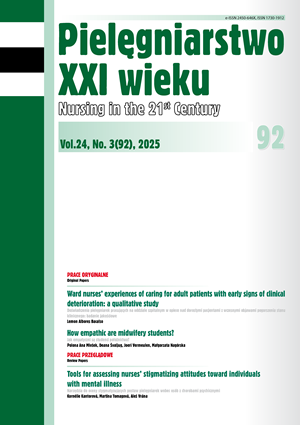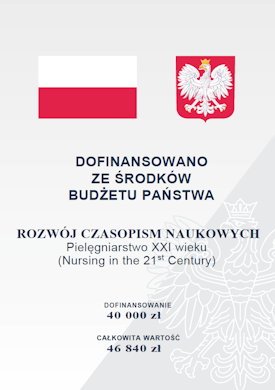How empathic are midwifery students?
DOI:
https://doi.org/10.12923/pielxxiw-2025-0027Keywords:
curriculum, empathic midwifery, students attitude, emotional workAbstract
HOW EMPATHIC ARE MIDWIFERY STUDENTS?
Aim. The aim of the described study was to evaluate levels of empathy among midwifery students in Faculties of Croatia, Slovenia, Belgium and Poland; each state representing diff erent regions of Europe, but at the same time all of them have similarities of midwifery education due to EU directives.
Material and methods. Quantitative study was undertaken, by using a validated research instrument – Midwifery Empathy Scale (MES) that was translated through double blind procedure for each country. A purposive sample of midwifery students was used, including students of 1st year, 2nd year and 3rd year undergraduate studies . The Ethics committee of the faculty approved the research design. Basic descriptive measures were calculated.
Results. The statement that achieved highest rating on MES scale was »I believe that empathy plays an important role in midwifery care«, while the least agreed upon were: »Women’s emotions do not concern me, I do not get emotionally aff ected when I see a woman cry and Very sensitive women irritate me«. Altogether, mean values did not diff er when comparing 1st year and last year midwifery students, with average score being 59 on a MES-R.
Conclusions. We can not conclude that current curriculum in the researched institutions foster empathy levels of the students, however some diff erences indicated possible cultural components.
References
1. Gaba DM. The future vision of simulation in health care. Qual. Saf. Heal. Care. 2004; 13(1):1-10. https://doi.org/10.1136/qshc.2004.009878
2. Lioce L, et al. Healthcare Simulation Dictionary – Second Edition, Rockville, MD Agency Healthc. Res. Qual. 2020.
3. Kohn LT, Corrigan JM, Donaldson MS. To err is human: building a safer health system. Washington, DC: National Academy Press. 1999.
4. Tomaszewska K, Majchrowicz B, Trojnar P, et al. Medical simulation as a method of practical training in the opinion of nursing students. Nursing in the 21st Century. 2023; 22:85-92. http://doi.org/10.2478/pielxxiw-2023-0016
5. Fisher M, Vishwas A, Cross S,et al. Simulation training for Police and Ambulance Services: improving care for people with mental health needs. BMJ Simul Technol Enhanc Learn. 2020; 6(2):121-122. https://doi.org/10.1136/bmjstel-2018-000423
6. Saber DA, Strout K, Caruso LS, et al. An interprofessional approach to continuing education with mass casualty simulation: planning and execution. J. Contin. Educ. Nurs. 2017;48(10):447-453. https://doi.org/10.3928/00220124-20170918-05
7. World Medical Association. Declaration of Helsinki, Ethical Principles for Scientific Requirements and Research Protocols. World Med. Assoc. 1964. 2024; 29–32. https://ww w.wma.net/policies-post/wma-declaration-of-helsinki-ethical¬principles-for-medical-research-involving-human-subjects/
8. Tong A, Sainsbury P, Braig J. Consolidated criteria for reporting qualitative research (COREQ): A 32-item checklist for interviews and focus groups. Int. J. Qual. Health Care. 2007; 19(6): 349-357. https://doi.org/10.1093/intqhc/mzm042
9. Faria-Schützer DB, Surita FG, Alves VLP, et al. Seven steps for qualitative treatment in health research: the Clinical-Qualitative Content Analysis. Cien. Saude. Colet. 2021; 26(1):265-274. https://doi.org/10.1590/1413-81232020261.07622019
10. Krueger RA, Casey MA. Designing and conducting focus group interviews. Social Analysis Selected Tools and Techniques. 2001;36:4-23.
11. Nestel D, Hui J, Kunkler K, et al. A practical guide healthcare simulation research. Cham: Springer Nature Switzerland AG; 2019.
12. Roche A, Watkins E, Pettit A, et al. Impact of prehospital ultrasound training on simulated paramedic clinical decision-making. West J. Emerg. Med. 2024;25(5):784-792. https://doi.org/10.5811/westjem.18439
13. Husain S, Eisenberg M. Police AED programs: A systematic review and meta-analysis. Resuscitation. 2013;84(9):1184-1191. https://doi.org/10.1016/j.resuscitation.2013.03.040
14. Williams-Bell F, Kapralos B, Hogue A, et al. Using serious games and virtual simulation for training in the fire service: a review. Fire Technol. 2015; 51(3): 553-584. https://doi.org/10.1007/s10694-014-0398-1
15. Guise JM, Hansen M, Lambert W, et al. The role of simulation in mixed-methods research: A framework & application to patient safety. BMC Health Serv. Res. 2017; 17(1):1-7. https://doi.org/10.1186/s12913-017-2255-7
16. State of Victoria. Simulation and Patient Safety: The Benefits for Your Organisation. Melbourne: Department of Health & Human Services; 2015, p. 22.
17. Kardong-Edgren S, Jeffries P. The NCSBN national simulation study: a longitudinal, randomized, controlled study replacing clinical hours with simulation in prelicensure nursing education. J. Nurs. Regul. 2014;5(2):3-40. https://doi.org/10.1016/S2155-8256(15)30062-4
18. Marshall C, Van Der Volgen J, Lombardo N, et al. A mixed methods approach to assess the impact of an interprofessional education medical error simulation. Am. J. Pharm. Educ. 2020;84 (2):217-230. https://doi.org/10.5688/ajpe7133
19. Kumar A, Ameh C. Start here- principles of effective undergraduate training. Best Pract. Res. Clin. Obstet. Gynaecol. 2022;80:114-125. https://doi.org/10.1016/j.bpobgyn.2021.11.010
20. Karunathilake I. The role of simulation in Postgraduate Medical Education. J. Postgrad. Inst. Med. 2018;5(1):67. https://doi.org/10.4038/jpgim.8185
21. Padrez KA, Brown J, Zanoff A, et al. Development of a simulation-based curriculum for Pediatric prehospital skills: a mixed-methods needs assessment. BMC Emerg. Med. 2021;21(1):1-10. https://doi.org/10.1186/s12873-021-00494-4
22. Abelsson A, Lundberg L.Simulation as a means to develop firefighters as emergency care professionals. Int. J. Occup. Saf. Ergon. 2019; 25(4):650-657. https://doi.org/10.1080/10803548.2018.1541122
23. Avery P, Thompson C, Cowburn P. Training the trainers: improving the quality of education delivered to paramedics through a simulation-debrief model. Br. Paramed. J. 2023;7(4):51-56. https://doi.org/10.29045/14784726.2023.3.7.4.51
Downloads
Published
Issue
Section
License
Copyright (c) 2025 Polona Ana Mivšek, Deana Švaljug, Joeri Vermeulen, Małgorzata Nagórska (Autor)

This work is licensed under a Creative Commons Attribution 4.0 International License.




